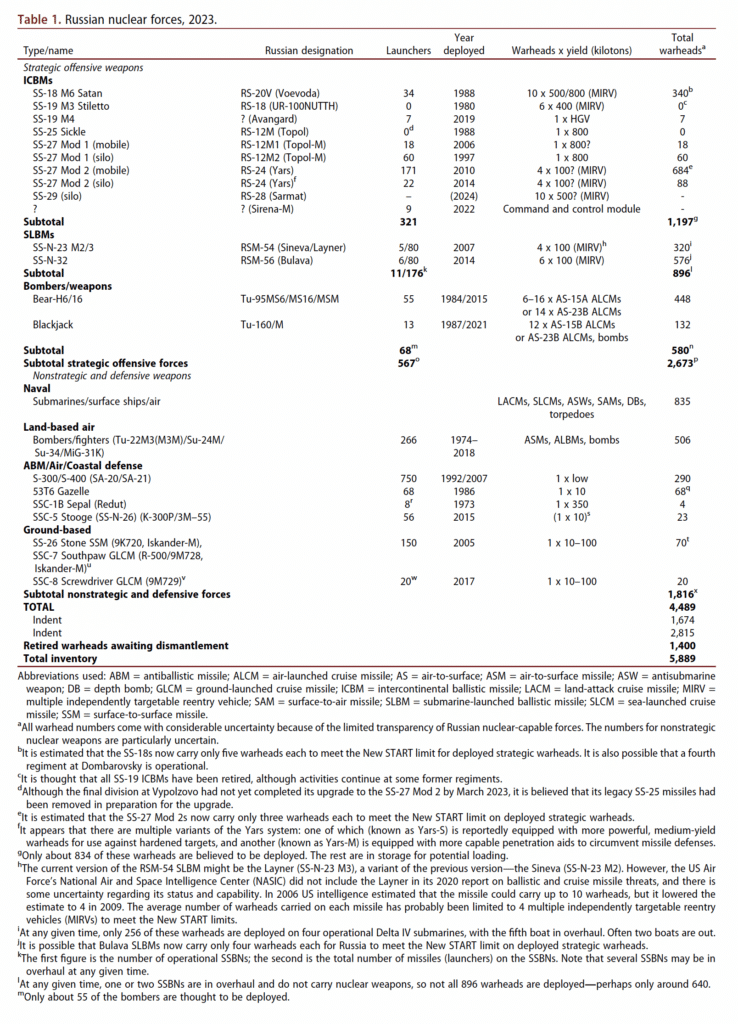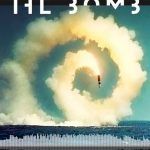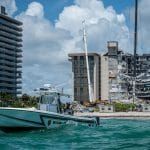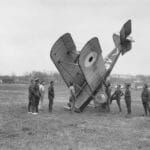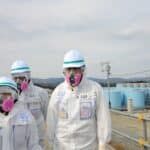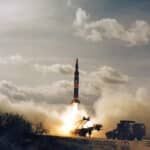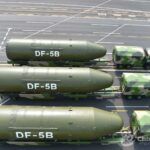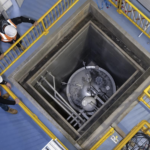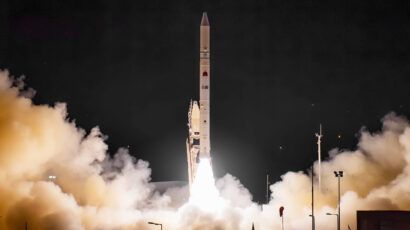Nuclear Notebook: Russian nuclear weapons, 2023
By Hans M. Kristensen, Matt Korda, Eliana Johns | May 9, 2023
Nuclear Notebook: Russian nuclear weapons, 2023
By Hans M. Kristensen, Matt Korda, Eliana Johns | May 9, 2023
The Nuclear Notebook is researched and written by the staff of the Federation of American Scientists’ Nuclear Information Project: director Hans M. Kristensen, senior research associate Matt Korda, and research associate Eliana Reynolds. The Nuclear Notebook column has been published in the Bulletin of the Atomic Scientists since 1987. This issue’s column examines Russia’s nuclear arsenal, which includes a stockpile of approximately 4,489 warheads. Of these, some 1,674 strategic warheads are deployed on ballistic missiles and at heavy bomber bases, while an approximate additional 999 strategic warheads, along with 1,816 nonstrategic warheads, are held in reserve. The Russian arsenal continues its broad modernization intended to replace most Soviet-era weapons by the late-2020s.
This article is freely available in PDF format in the Bulletin of the Atomic Scientists’ digital magazine (published by Taylor & Francis) at this link. To cite this article, please use the following citation, adapted to the appropriate citation style: Hans M. Kristensen, Matt Korda, and Eliana Reynolds, Russian Nuclear Weapons, 2023, Bulletin of the Atomic Scientists, 79:3, 174-199, DOI: https://doi.org/10.1080/00963402.2023.2202542
To see all previous Nuclear Notebook columns, go to https://thebulletin.org/nuclear-notebook/
As of early 2023, we estimate that Russia has a stockpile of approximately 4,489 nuclear warheads assigned for use by long-range strategic launchers and shorter-range tactical nuclear forces. This is a net increase of approximately 12 warheads from last year, largely due to the addition of new intercontinental ballistic missiles and one new ballistic missile submarine, as well as the retirement of older warheads. Of the stockpiled warheads, approximately 1,674 strategic warheads are deployed: about 834 on land-based ballistic missiles, about 640 on submarine-launched ballistic missiles, and possibly 200 at heavy bomber bases. Approximately another 999 strategic warheads are in storage, along with about 1,816 nonstrategic warheads. In addition to the military stockpile for operational forces, a large number—approximately 1,400—of retired but still largely intact warheads await dismantlement, for a total inventory of approximately 5,889 warheads[1] (see Table 1).
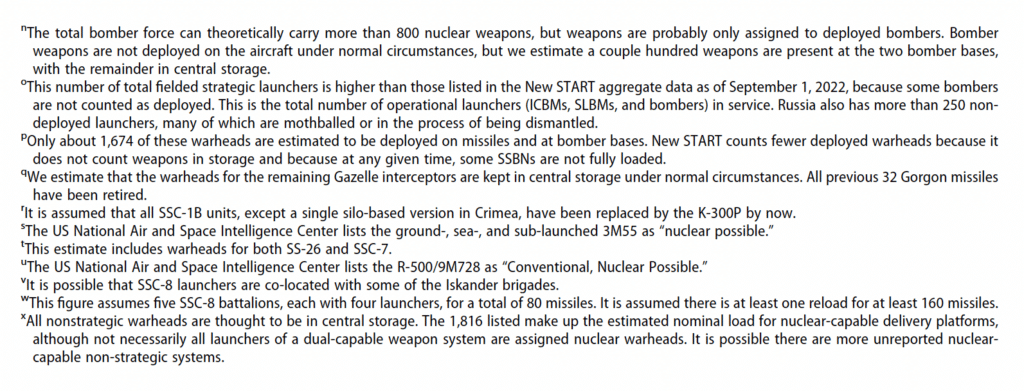
Russia is in the late stages of a decades-long modernization of its strategic and nonstrategic nuclear forces to replace Soviet-era weapons with newer systems. In December 2022, Russian Defence Minister Sergei Shoigu reported that modern weapons and equipment now make up 91.3 percent of Russia’s nuclear triad, an increase of 2.2 percent from the previous year (Russian Federation 2022a). These modernization percentage values probably come with significant uncertainty, as it is unclear what methodology Russia is using to make those calculations. In previous years, Putin’s remarks have emphasized the need for Russia’s nuclear forces to keep pace with Russia’s competitors: “It is absolutely unacceptable to stand idle. The pace of change in all areas that are critical for the Armed Forces is unusually fast today. It is not even Formula 1 fast—it is supersonic fast. You stop for one second and you start falling behind immediately” (Russian Federation 2020).
Russia’s nuclear modernization program appears motivated in part by the Kremlin’s strong desire to maintain overall parity with the United States and to maintain national prestige, but also to compensate for inferior conventional forces as well as the Russian leadership’s apparent conviction that the US ballistic missile defense system constitutes a real future risk to the credibility of Russia’s retaliatory capability. The poor performance of Russian conventional forces in the war against Ukraine and depletion of weapon stockpiles will likely deepen Russian reliance on nuclear weapons for its national defense. Throughout its war in Ukraine, Russia has conducted a series of missile strikes using long-range dual-capable precision weapons, such as Kh-101 air-launched cruise missiles, sea-launched 3 M–54 Kalibr cruise missiles, 9-A-7760 Kinzhal ballistic missiles, and ground-launched Iskander missiles (Interfax 2022b, 2022c; Reuters 2023a). Additionally, the United Kingdom Ministry of Defense has released several intelligence reports identifying that Russia has used unarmed munitions and aging cruise missiles without nuclear warheads in Ukraine, including the Kh-55 (AS-15 Kent) (United Kingdom Ministry of Defence 2022, 2023). Russian forces have also repurposed anti-ship missiles and missile defense systems including the S-300 for ground-strike capabilities, which some analysts assume to be another sign that Russia’s longer-range weapons stockpile is dwindling as the length of the war drags on (Interfax 2022d)
Policy and strategy aside, the development of multiple weapon systems, rather than focusing resources on one or two, also indicates the strong influence of the military-industrial complex on Russia’s nuclear posture planning (Luzin 2021).
Russia’s nuclear modernization programs—combined with an increase in the number and size of its military exercises and occasional explicit nuclear threats against other countries—contribute to uncertainty about Russia’s long-term intentions and growing international debate about the nature of its nuclear strategy. These concerns, in turn, stimulate increased defense spending, nuclear modernization programs, and political opposition to further nuclear weapons reductions in Europe and the United States.
Russian noncompliance with the New START Treaty
By February 2018, Russia had significantly reduced (downloaded) the number of warheads deployed on its ballistic missiles to meet the central limit of the New Strategic Arms Reduction Treaty (New START) of no more than 1,550 deployed strategic warheads (Russian Federation Foreign Affairs Ministry 2018). The exact breakdown of Russia’s nuclear weapons is unknown because Russia, unlike the United States, does not publish an unclassified overview of its strategic forces. However, it is estimated that the reduction may have involved scaling back the number of warheads on each SS-18 and SS-27 Mod 2 intercontinental ballistic missile (ICBM), as well as on each SS-N-32 submarine-launched ballistic missile (SLBM). This demonstrates that New START places real constraints on Russia’s deployed strategic forces. The result appears to be an increased reliance on a strategic reserve of nondeployed warheads that can be loaded onto missiles to increase the size of the force—a strategy the United States has relied on for several decades.
The most recent New START data exchange, declared on September 1, 2022, listed Russia as having 1,549 deployed warheads attributed to 540 strategic launchers (US Department of State 2022a). These numbers differ from the estimates presented in this Nuclear Notebook because the New START counting rules artificially attribute one warhead to each deployed bomber, even though Russian bombers do not carry nuclear weapons under normal circumstances. Additionally, this Nuclear Notebook counts weapons stored at bomber bases that can quickly be loaded onto the aircraft as “deployed.”
Russia, like the United States, could potentially upload several hundreds of additional warheads onto their launchers but is prevented from doing so by the New START central limit. The treaty provides an important node of transparency for both Russia’s and the United States’ strategic nuclear forces: As of March 2023, the United States and Russia have completed a combined 328 on-site inspections and exchanged over 25,000 notifications (US Department of State 2022b); however, no on-site inspections have taken place since April 2020—at first due to the COVID-19 pandemic and then due to Russia’s refusal to allow US inspections (Post 2021; US Department of State 2022c).
On August 9, 2022, in response to a US treaty notification expressing an intent to conduct an inspection, Russia refused the request and invoked an infrequently used treaty clause to “temporarily exempt” all of its facilities from inspection. At the time, the Russian Ministry of Foreign Affairs stated: “Russia was forced to resort to this measure as a result of Washington’s persistent desire to implicitly achieve a restart of inspection activities on conditions that do not take into account existing realities, create unilateral advantages for the United States and effectively deprive the Russian Federation of the right to carry out inspections on American soil” (Russian Federation Foreign Affairs Ministry 2022a).
For its part, the United States stated that “Russia’s claim of being unable to exercise its inspection rights in the United States is false [. . .] Contrary to Russia’s claim that Russian inspectors cannot travel to the United States to conduct inspections, Russian inspectors can in fact travel to the United States via commercial flights or authorized inspection airplanes. There are no impediments arising from U.S. sanctions that would prevent Russia’s full exercise of its inspection rights under the Treaty” (US Department of State 2022c, 11).
The Department of State’s New START implementation report suggested that the primary reason for suspending inspections “centered on Russian grievances regarding U.S. and other countries’ measures imposed on Russia in response to its unprovoked, full-scale invasion of Ukraine” (US Department of State 2022c, 9). This comports with how the Russian Foreign Ministry’s spokesperson Maria Zakharova described Russia’s decision to indefinitely postpone a scheduled meeting of the Bilateral Consultative Commission in November 2022, the day before it was supposed to take place: “Such a situation could not but affect the sphere of arms control, which cannot be regarded as something autonomous and existing in isolation from geopolitical realities. You need to have a very peculiar logic to tell Russia about restraint, transparency and predictability in military matters, while simultaneously helping the Kiev regime to kill our military and civilians in the Russian regions, providing increasingly destructive means of armed struggle and sending American instructors to Ukraine, advisers and mercenaries” (Interfax 2022a). Despite this grievance, Zakharova added that “Russia continues to regard the [New] START Treaty as an important tool for ensuring predictability and preventing an arms race. It continues to meet the interests of both parties. In particular, the uninterrupted exchange of notifications on the status of [New] START plays a significant stabilizing role” (Interfax 2022a).
After Russia refused to allow inspections and convene a meeting of the BCC, on January 31, 2023, the US Department of State declared Russia to be in a state of “noncompliance” with specific clauses of New START (US Department of State 2022c). It is crucial to note, however, the treaty makes the distinction between findings of “noncompliance” (serious, yet informal assessments, often with a clear path to reestablishing compliance), “violation” (requiring a formal determination), and “material breach” (where a violation rises to the level of contravening the object or purpose of the treaty).
The United States’ findings of Russian noncompliance were not related to the actual number of deployed Russian warheads and launchers. While the Department of State noted that the lack of inspections means that “the United States has less confidence in the accuracy of Russia’s declarations,” its report was careful to note that: “While this is a serious concern, it is not a determination of noncompliance” (US Department of State 2022c, 6). The US Department of State also assessed that “Russia was likely under the New START warhead limit at the end of 2022” and that Russia’s noncompliance does not threaten the national security interests of the United States (US Department of State 2022c, 6).
On February 21, 2023, President Vladimir Putin announced Russia’s intention to “suspend” its participation in New START. As he stated in his speech: “To reiterate, we are not withdrawing from the Treaty, but rather suspending our participation. Before we come back to discussing this issue, we must have a clear idea of what NATO countries such as France or Great Britain have at stake, and how we will account for their strategic arsenals, that is, the Alliance’s combined offensive capabilities” (Russian Federation 2023). New START, however, does not include a formal provision for “suspending” the treaty as President Putin has declared. In the same speech, Putin also claimed that the United States was preparing to conduct nuclear tests and suggested that “the Defence Ministry and Rosatom must make everything ready for Russia to conduct nuclear tests. We will not be the first to proceed with these tests, but if the United States goes ahead with them, we will as well.”
Russian officials have since clarified Putin’s words saying that, although Russia will no longer exchange data and notifications pursuant to the treaty—and did not exchange its March 2023 nuclear forces data with the United States as mandated by the treaty—it still intends to abide by New START’s central limits (Cordell 2023; Lee 2023). If Russia decided to exceed the treaty’s limits, it could theoretically upload hundreds of warheads onto its deployed delivery systems, possibly increasing its deployed nuclear arsenal by about 60 percent (Korda and Kristensen 2023). How quickly this could be done depends largely upon the weapon system: Bombers could be uploaded in a matter of hours or days, whereas a complete upload of the submarines and ICBMs could take months or even years given the time it takes to return submarines to port and change the warhead configuration on each ICBM.
What is Russia’s nuclear strategy?
The international debate about Russia’s nuclear strategic thinking has reached a new level of intensity, particularly after Russia’s invasion of Ukraine in February 2022. Russia’s official deterrence policy, which was last updated in 2020, lays out explicit conditions under which it could launch nuclear weapons: to retaliate against an ongoing attack “against critical governmental or military sites” by ballistic missiles, nuclear weapons or other weapons of mass destruction (WMD), and to retaliate against “the use of conventional weapons when the very existence of the state is in jeopardy” (Russian Federation Foreign Affairs Ministry 2020). Despite prior US assumptions of a shift toward greater reliance on potential first use of nuclear weapons surrounding a potential low-yield “escalate-to-deescalate” policy, Russia’s official policy is largely consistent with previous public iterations of Russian nuclear strategy (US Department of Defense 2018, 30). This includes remarks that President Putin made to the Valdai Club in October 2018, when he stated that “Our nuclear weapons doctrine does not provide for a preemptive strike.” Rather, he continued, “our concept is based on a reciprocal counter strike . . . This means that we are prepared and will use nuclear weapons only when we know for certain that some potential aggressor is attacking Russia, our territory” (Russian Federation 2018a). This is additionally consistent with previous iterations of Russian nuclear policy, which has largely remained unchanged since President Putin came to power in 2000 (Russian Federation 2014, 2010).
Although some initial reports interpreted Putin’s 2018 Valdai Club comments to mean that Russia might be adopting a nuclear no-first-use policy, this does not seem to be the case; his remarks were more likely meant to respond to the 2018 US Nuclear Posture Review’s claim that Russia had lowered its threshold for first use of nuclear weapons in a conflict (Stowe-Thurston, Korda, and Kristensen 2018). The Biden Administration seemed to walk back the prior administration’s assumption with the release of the 2022 Nuclear Posture Review, which does not include language around the alleged “escalate-to-de-escalate policy.” Instead, it simply states that Russia is diversifying its arsenal and that it views its nuclear weapons as “a shield behind which to wage unjustified aggression against [its] neighbors” (US Department of Defense 2022, 1).
In January 2022, Russia joined the four other permanent members of the United Nations Security Council in stating that “a nuclear war cannot be won and must never be fought” (The White House 2022). However, Russian officials have made many statements about nuclear weapons that appear to go beyond the published doctrine, threatening to potentially use them in situations that do not meet the conditions described.
For example, although Russian Foreign Minister Sergey Lavrov confirmed in an April 25 interview that Russia is “committed” to the P5 statement that a nuclear war must never be fought, he further elaborated that the “risks are quite high today” and that the threat must “not be underestimated” (Russian Federation Foreign Affairs Ministry 2022b).
Moreover, the fact that Russian military planners are pursuing a broad range of upgraded and new versions of nuclear weapons suggests that the real doctrine goes beyond basic deterrence and toward regional war-fighting strategies, or even weapons aimed at causing terror.
One widely cited example involves the so-called Status-6—known in Russia as “Poseidon” and in the United States as “Kanyon”—a long-range nuclear-powered torpedo that a Russian government document described as intended to create “areas of wide radioactive contamination that would be unsuitable for military, economic, or other activity for long periods of time” (Podvig 2015). A diagram and description of the proposed weapon, first revealed in a Russian television broadcast, can still be seen on YouTube (YouTube 2015). The weapon, which is under development, appears designed to attack harbors and cities to cause widespread indiscriminate collateral damage in a clear violation of international law.
Nuclear signaling in Russia’s war in Ukraine
The nuclear signaling by President Vladimir Putin and other Russian officials throughout the duration of the war in Ukraine has raised questions about Russia’s nuclear doctrine, specifically where, how, and when Russia might use a nuclear weapon. On February 24, 2022, Putin announced a “special military operation” against Ukraine, after which Russia conducted a full-scale invasion against major Ukrainian cities and military installations, conducting multiple airstrikes and entering Ukraine through its southern, northern, and eastern borders. In his speech, Putin threatened, “no matter who tries to stand in our way or [. . .] create threats for our country and our people, they must know that Russia will respond immediately, and the consequences will be such as you have never seen in your entire history” (Russian Federation 2022b).
A few days after the invasion, Putin placed Russia’s nuclear arsenal on “high alert,” saying that “aggressive statements” from NATO caused him to increase the readiness of the weapons (Russian Federation 2022c). It appears that this order was primarily related to enhancing staffing levels and nuclear command and control, rather than the deployment of additional nuclear systems. As of March 2023, none of Russia’s strategic nuclear weapons or delivery systems had conducted any unusual deployment patterns in the context of the war in Ukraine.
After Russia conducted the first test launch of the Sarmat in April 2022, Putin said the weapon will “ensure Russia’s security against external threats and will be a wakeup call for those who are trying to threaten our country in the frenzy of rabid, aggressive rhetoric” (Russian Federation 2022d). He later stated that “those who try to blackmail us with nuclear weapons should know that the weathervane can turn and point toward them” (Russian Federation 2022e). Additionally, Putin has insisted that “in the event of a threat to the territorial integrity of our country and to defend Russia and our people, we will certainly make use of all weapon systems available to us. This is not a bluff” (Russian Federation 2022e). Putin’s rhetoric has been echoed by other officials, including calls for Russia to use low-yield nuclear weapons and false accusations of Ukraine preparing to use a radioactive dirty bomb (Light 2022; Reuters 2022).
Russia’s nuclear signaling appears to have been mainly intended to deter the United States and NATO from intervening directly with military forces in Ukraine to prevent a wider war. However, this has triggered widespread international fears about the extent to which this invasion could have significant implications for the global nuclear order. In the words of UN Secretary-General Antonio Guterres, “the prospect of nuclear conflict, once unthinkable, is now back within the realm of possibility” (United Nations 2022).
Perhaps in reaction to such fears and direct warnings from the United States about the consequences of Russia using nuclear weapons, a member of Russia’s delegation to the United Nations General Assembly in November 2022 appeared to lower the temperature by insisting that Russia’s nuclear doctrine remained unchanged after the invasion of Ukraine: “In response to today’s absolutely ungrounded accusation that Russia allegedly threat[ened] to use nuclear weapons during the special military operation in Ukraine, we would like to stress once again that Russia’s doctrine in this sphere is purely defensive and does not allow any broad interpretation” (TASS 2022a). Deputy Foreign Minister Sergei Ryabkov also declared that “what is happening in and around Ukraine does not affect Russia’s approach to nuclear deterrence” when addressing why Russia postponed the New START meeting with the United States that was originally scheduled for November 2022 (Kryukov 2022).
Yet in March 2023, President Putin reinvigorated nuclear signaling by declaring that by July 1st, Russia would complete the construction of a “special storage facility for tactical nuclear weapons” on the territory of Belarus (Smotrim 2023). Despite Putin’s announcement, it remains highly unclear whether Russia actually intends to deploy nuclear weapons on Belarusian territory, or whether it is developing the infrastructure needed to potentially deploy them in the future. It is also unclear where and how Russia will build this storage site within such a short timeline given it took Russia years to upgrade other storage sites (Kristensen 2018). Echoing remarks made with Belarusian President Alexander Lukashenko in 2022, President Putin noted that Russia had re-equipped 10 Belarusian Su-25 aircraft with the ability to deliver nuclear weapons, and that Russia had transferred dual-capable Iskander (SS-26) launchers to Belarus as well (Smotrim 2023). Several open-source clues suggest that Lida Air Base, located only 40 kilometers from the Lithuanian border and the only Belarusian Air Force wing equipped with the Su-25, is the most likely candidate for Russia’s new ”nuclear sharing” mission in Belarus (Korda, Reynolds, and Kristensen 2023).
Intercontinental ballistic missiles
Russia’s Strategic Rocket Force currently deploys several variants of silo-based and mobile ICBMs. The silo-based ICBMs include the SS-18, SS-19 Mod 4, SS-27 Mod 1, and SS-27 Mod 2, while the mobile ICBMs include the SS-27 Mod 1 and SS-27 Mod 2.
Based on what we can observe via satellite images, combined with information from Russian officials and New START’s data exchanges, Russia appears to have approximately 312 nuclear-armed ICBMs, which we estimate can carry up to 1,197 warheads (see Table 1). Modernization of the ICBM force also involves equipping upgraded silos with new air and perimeter-defense systems, and the new Peresvet laser has been deployed with at least five road-mobile ICBM divisions for the purpose of “covering up their maneuvering operations” (Russian Federation Defense Ministry 2019; Sanders 2021), possibly implying that one role of Peresvet is to blind spy-satellites.
The ICBMs are organized under the Strategic Rocket Forces in three missile armies with a total of 12 divisions consisting of approximately 40 missile regiments (see Table 2). The regiment in the missile division at Yurya operates the Sirena-M—a system that is based off the SS-27 Mod 2 ICBM—that is believed to serve as a back-up launch code transmitter and is therefore not nuclear-armed. The ICBM force has been declining in number for three decades, and Russia claims to be 85 percent of the way through a modernization program to replace all Soviet-era missiles with newer types on a less than one-for-one basis (Krasnaya Zvezda 2022). In December 2022, Col. Gen. Sergei Karakaev—the commander of Russia’s Strategic Rocket Forces—implied that Russia was in the process of completely retiring the SS-25 ICBM, one of the last Soviet-era ICBMs: “By removing the last Topol autonomous launcher from combat duty, we are actually saying goodbye to the era of fourth-generation mobile missile systems” (Krasnaya Zvezda 2022). Although the final division at Vypolzovo had not yet completed its upgrade to the SS-27 Mod 2 by the end of 2022, it is believed that its legacy SS-25 missiles had been removed in preparation for the upgrade. As a result, we assess that the last remaining Soviet-era ICBM in the Russian arsenal is the SS-18 (although some SS-19s have been reconfigured to carry the Avangard hypersonic glide vehicle).
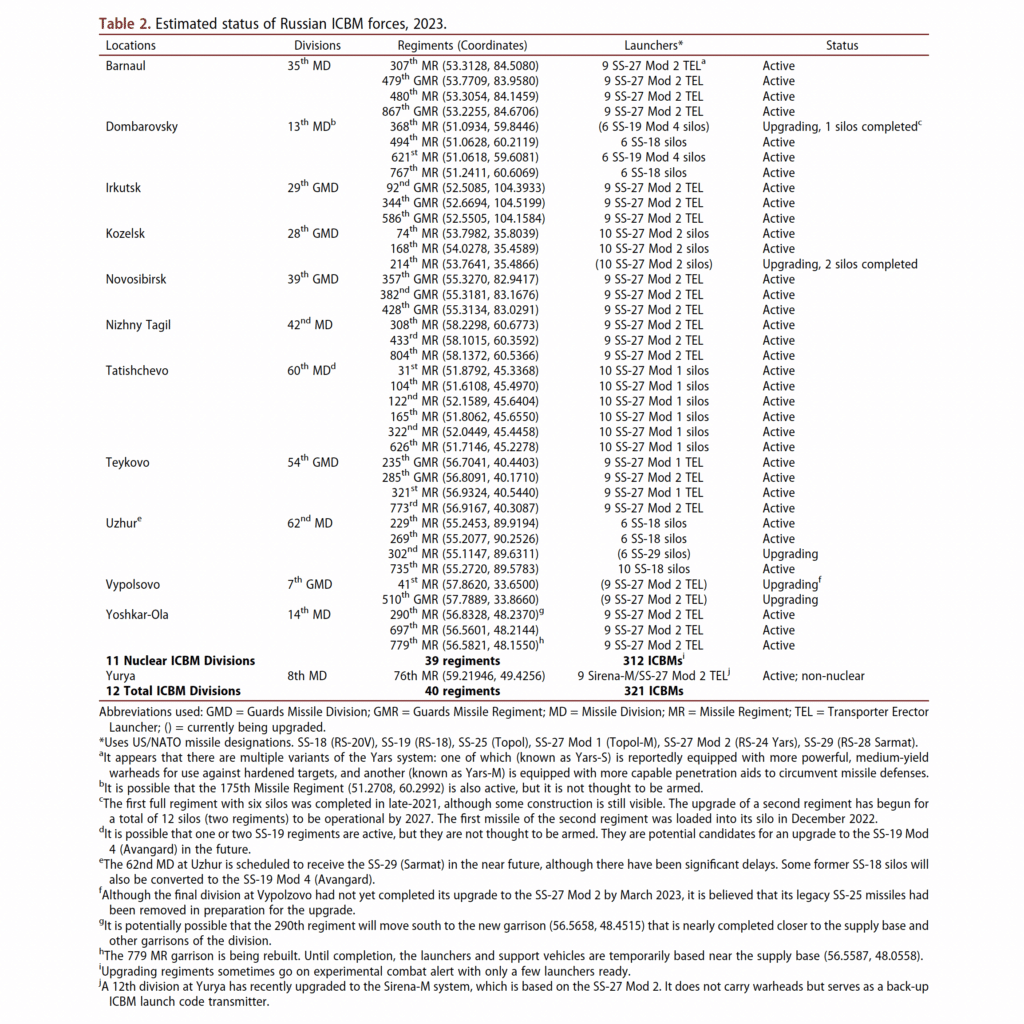
The SS-18 (RS-20V or R-36M2 Voevoda) is a silo-based, 10-warhead heavy ICBM first deployed in 1988. It is reaching the end of its service life, with approximately 34 SS-18s that can carry up to 340 warheads remaining in the 13th Missile Division at Dombarovsky and the 62nd Missile Division at Uzhur. We estimate that the number of warheads on each SS-18 has been reduced for Russia to meet the New START limit for deployed strategic warheads. The SS-18 formally began retiring in 2021 to prepare for the introduction of the SS-29 (Sarmat or RS-28) ICBM at the Uzhur missile field (Krasnaya Zvezda 2021a). Commercial satellite imagery indicates that the 302nd Missile Regiment has already been disarmed to accommodate for Sarmat-related upgrades to the regiment’s silos and launch control center (Figure 1).
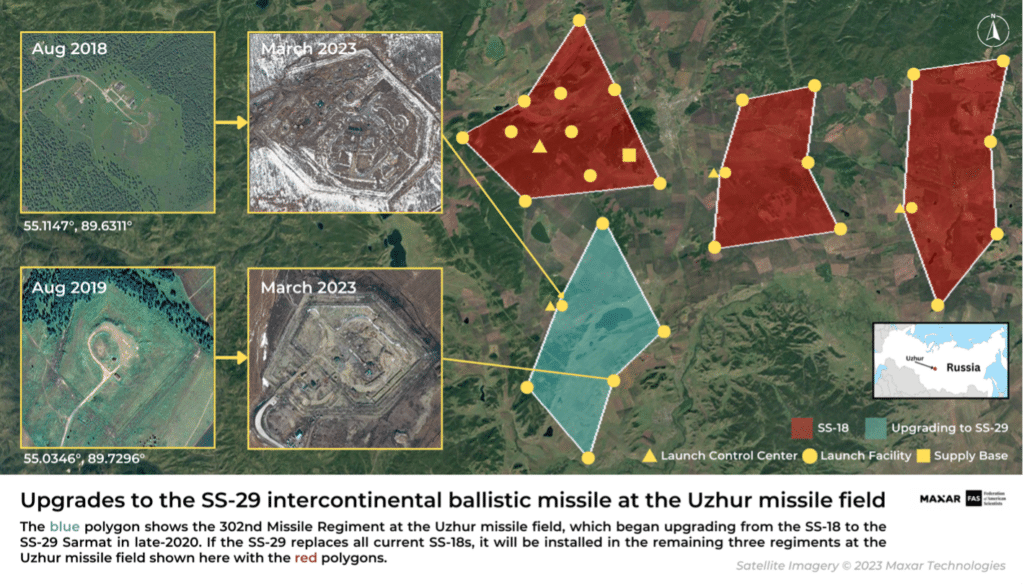
The silo-based, six-warhead SS-19 (RS-18 or UR-100NUTTKh), which entered service in 1980, appears to have been retired from combat duty. A small number of converted SS-19s are being deployed with two regiments of the 13th Missile Division at Dombarovsky as the SS-19 Mod 4 with the new Avangard hypersonic glide vehicles (see below). In October 2021, Russian officials announced that the service life of the SS-19 had been extended until at least 2023; this is probably to allow the missile’s boosters to be used for the Mod 4 Avangard deployment (RIA Novosti 2021a).
The new ICBMs include two versions of the SS-27: the Mods 1 and 2. The SS-27 Mod 1 is a single-warhead missile, known in Russia as Topol-M, that comes in either mobile (RS-12 M1) or silo-based (RS-12 M2) variants. Deployment of the SS-27 Mod 1 was completed in 2012 with a total of 78 missiles: 60 silo-based missiles with the 60th Missile Division in Tatishchevo, and 18 road-mobile missiles with the 54th Guards Missile Division at Teykovo. Russian officials indicated in 2019 that the Topol-M units eventually will be upgraded to RS-24 Yars as well.
The focus of the current and larger phase of Russia’s modernization is the SS-27 Mod 2, known in Russia as the RS-24 (Yars), which is a modified SS-27 Mod 1 (or Topol-M) that can carry up to four multiple independently targetable reentry vehicles (MIRVs). It appears that there are several variants of the Yars system: one of which (known as Yars-S) is reportedly equipped with more powerful, medium-yield warheads for use against hardened targets, and another (known as Yars-M) is equipped with more capable penetration aids to circumvent missile defenses (Kornev and Ramm 2021).
During an interview with Col. Gen. Sergei Karakaev in December 2020, the Russian Defense Ministry’s TV channel declared that approximately 150 mobile and silo-based Yars had been deployed by the Strategic Rocket Force (Zvezda 2020). We estimate that as of January 2022, this number has grown to approximately 193 mobile and silo-based Yars missiles. SS-27 Mod 2 upgrades now appear to be complete at the 39th Guards Missile Division at Novosibirsk, the 42nd Missile Division at Nizhny Tagil, the 14th Missile Division at Yoshkar-Ola, the 29th Guards Missile Division at Irkutsk, and the 35th Missile Division at Barnaul. Although these divisions now all have been equipped with the SS-27 Mod 2, some of the garrisons are not equipped to accommodate all the vehicles required to support the launchers and will continue to undergo construction for several years. After several years of temporarily basing the 382nd Guards Missile Regiment at a temporary open-air location, commercial satellite imagery now indicates that the possible permanent garrison is nearing completion.
The last mobile ICBM division to be upgraded to SS-27 Mod 2 is the 7th Missile Division at Vypolsovo. In December 2022, Col. Gen. Karakaev stated that one regiment had begun combat duty by the end of 2022, and the entire division’s upgrade to Yars would be completed in 2023 (Krasnaya Zvezda 2022). To prepare for the upgrade, we believe that the entire division has already been fully disarmed of its SS-25 ICBMs, meaning that this missile—first deployed in the mid-1980s—is now completely out of service across the entirety of Russia’s Strategic Rocket Forces.
The 28th Guards Missile Division at Kozelsk is the only silo division with SS-27 Mod 2 and continues to expand: The first regiment (the 74th Missile Regiment) officially began combat duty with its full complement of 10 missiles in November 2018, after initially being declared operational (likely with just six missiles) in 2015 (Russian Federation Defense Ministry 2018a). Satellite pictures show that upgrades of the second regiment (the 168th Missile Regiment) are complete, as was confirmed by Col. Gen. Karakaev at the end of 2020. (TASS 2020a). In December 2021, Col. Gen. Karakaev stated that the third missile regiment at Kozelsk (the 214th Missile Regiment) had been placed on combat alert, and in December 2022, the first two SS-27 Mod 2 ICBMs were loaded into their silos (Russia Federation Defense Ministry 2022). Satellite imagery suggests, however, that the necessary infrastructure upgrades have only taken place at a small number of silos and are still ongoing. As a result, given the time it took to complete the upgrades of the first two regiments at Kozelsk, it remains uncertain whether the Yars upgrade will be fully completed by 2024 as scheduled.
Apart from the missiles and silos themselves, the ICBM upgrade involves extensive modification of external fences, internal roads, and support facilities. Each site is also receiving a new “Dym-2” perimeter defense system including automated grenade launchers, small arms fire, and remote-controlled machine gun installations (Krasnaya Zvezda 2021a; Russia Insight 2018).
Final development and deployment of a compact SS-27 version, known as Rubezh (Yars-M or RS-26), appears to have been delayed at least until the next armament program in the late 2020s (TASS 2018a). A rail-based version known as Barguzin appears to have been canceled.
The next major phase of Russia’s ICBM modernization will be the replacement of the SS-18 (RS-20V) with the SS-29 (RS-28) Sarmat. Satellite images show that upgrades of the first regiment (the 302nd) at Uzhur have been underway since 2021. Three ejection tests were conducted in December 2017, March 2018, and May 2018 at the Plesetsk Space Center, involving the cold launch and test firing of the Sarmat’s first stage and booster engine. After years of manufacturing and technical delays—reportedly having to do with the missile’s command module—the first Sarmat flight test took place in April 2022 (Russian Federation 2022d; War Bolts (Военно-болтовой) 2022). Russia initially planned to conduct at least four additional test launches throughout 2022 to satisfy President Putin’s declaration that Sarmat would enter combat duty by the end of the year (TASS 2021a; Kamchatka Info 2022; Interfax 2022e); however, as of April 2023, only one additional test had reportedly taken place and, according to US officials, likely ended in failure (Liebermann and Bertrand 2023). Despite the lack of successful tests, in November 2022 the General Director of the Russian Academy of Sciences claimed that Sarmat had already entered serial production (Emelyanenkov 2022).
There are many rumors about the SS-29. Some media sources have dubbed this missile the “Son of Satan” because it is a follow-on to the SS-18, which the United States and NATO designated “Satan”—presumably to reflect its extraordinary destructive capability. Rumors that the SS-29 could carry 15 or more MIRV warheads, though, seem exaggerated. We expect that it will carry about the same number as the SS-18 plus penetration aids. It is likely that a small number will be equipped to carry the Avangard hypersonic glide vehicle, which are currently being installed on a limited number of SS-19 Mod 4 boosters at Dombarovsky. If the SS-29 replaces all current SS-18s, it will be installed in a total of 46 silos of the three regiments at the Dombarovsky missile field and four regiments at the Uzhur missile field (six regiments of six missiles and one regiment of 10 missiles). It appears that the first regiment to receive Sarmat might be the 302nd Missile Regiment; upgrades to the regiment’s silos are clearly visible on commercial satellite imagery, indicating that the regiment’s SS-18s have already been removed.
The new Avangard hypersonic glide vehicle is designed to evade missile defenses and is initially being fitted atop modified SS-19 missiles (SS-19 Mod 4) at Dombarovsky and possibly later on SS-29 missiles at Uzhur. Russia is currently deploying the new weapon at a rate of two per year: the first two missiles at Dombarovsky began combat duty on December 27th, 2019, followed by another two in December 2020 (TASS 2019a; Russian Federation Defense Ministry 2020a). The regiment received its final two missiles—achieving a full complement of six missiles—in December 2021 (Russian Federation 2021a). The first missile in the second Avangard regiment was reportedly placed on combat duty in December 2022, and the entire regiment is scheduled to complete its rearmament by the end of 2027 to coincide with the completion of the current state armament program (Krasnaya Zvezda 2022). Similar to the new silos at Kozelsk, the modified Dombarovsky silos appear to have some form of perimeter defense system.
In December 2021, Karakaev stated that “a new mobile ground-based missile system” is being developed and, in December 2022, noted that the system would have “greater mobility” than Yars and would officially begin development in 2023 (Krasnaya Zvezda 2021a, 2022). This probably refers to the Osina-RV ICBM, a follow-on system reportedly derived from the Yars ICBM (War Bolts (Военно-болтовой) 2021), or perhaps the “Kedr” project. However, it remains unclear whether Kedr refers to a specific type of next-generation ICBM, or whether it is the name of the overall campaign to develop a new suite of next-generation strategic missile systems (TASS 2021b).
While the 2018 Nuclear Posture Review anticipated that Russian missile forces will increase over time, the evidence for this still is not clear. The US National Air and Space Intelligence Center predicted in 2020 that “the number of missiles in the Russian ICBM force will continue to decrease because of arms control agreements, aging missiles, and resource constraints” (US Air Force 2020, 26). With the ongoing modernization, the force level will likely level out as the modernization program is completed, although the modernized force will be able to deliver more warheads if all the single-warhead Topol-M (SS-27 Mod 1) ICBMs are replaced with MIRVed Yars (SS-27 Mod 2).
According to Col. Gen. Karakaev, Russia planned to conduct at least 10 ICBM launches in 2022, but only managed to conduct four (Krasnaya Zvezda 2021a, 2022). In December 2022, Karakaev announced that Russia would aim to conduct eight ICBM launches in 2023, the first of which occured on April 11th from the Kapustin Yar test site in Astrakhan oblast (Krasnaya Zvezda 2022). The Strategic Rocket Force often test-launches its missiles to the Sary-Shagan test site in Kazakhstan. However, given that Kazakhstan is a state party to the Treaty on the Prohibition of Nuclear Weapons, which entered into force in January 2021, it is unclear whether this will have an effect on Russia’s ICBM test site at Sary-Shagan. Notably, the April 11th ICBM test was launched to Sary-Shagan (TASS 2023h). Article 4(2) of the treaty notes that each state party must ensure “the elimination or irreversible conversion of all nuclear-weapons-related facilities” (United Nations 2017). As a result, Kazakhstan could request that Russia abstain from testing nuclear-capable ICBMs on its territory. This potential issue could explain why Russia is building a new testing ground for its Sarmat at Severo-Yeniseysky—a decision announced in December 2020, although construction has also been delayed (Russian Federation 2020).
Russia is also developing a nuclear-powered, ground-launched, nuclear-armed cruise missile with intercontinental range, known as 9M730 Burevestnik (NATO’s designation is SSC-X-9 Skyfall). This missile has faced serious setbacks: According to US military intelligence, it has failed nearly a dozen times since its testing period began in June 2016 (Panda). In November 2017, a failed test resulted in the missile being lost at sea, which required a substantial recovery effort (Macias 2018). A similar recovery effort in August 2019 resulted in an explosion that killed five scientists and two soldiers at Nenoksa; the explosion’s connection to Skyfall was confirmed by US State Department officials in October 2019 (DiNanno 2019). Due to these setbacks, it is possible that the Burevestnik program has been put on pause; there have been no declared tests of the system since 2019 and, unlike other elements of Russia’s nuclear forces, it has not been mentioned by high-profile Russian officials since then. In August 2021, satellite imagery appeared to indicate that Russia was preparing for another test of the Burevestnik system at Novaya Zemlya; however, it appears unlikely that a test ever took place (Lewis 2021; Cohen 2021).
Submarines and submarine-launched ballistic missiles
The Russian Navy operates 11 nuclear-powered nuclear-armed ballistic missile submarines (SSBNs) of two classes: five Delta IV (Project 667BRDM) and six (with a planned total of 10) Borei (Project 955), two of which are improved Borei-A (Project 955A) submarines. Some Russian defense sources indicate that an extra two additional Borei-class submarines may also be built eventually (TASS 2022b). The number of SSBNs is higher than the previous year’s estimate because Russia introduced one new Borei-A SSBN—Generalissimus Suvorov—in 2022 (Russian Federation 2022f; TASS 2022c). Each submarine can carry 16 SLBMs, and each SLBM can carry several MIRVs, for a combined maximum loading of approximately 896 warheads. However, not all these submarines are fully operational, and the warhead loading on some of the missiles may have been reduced as part of New START implementation. One or two SSBNs are normally undergoing repairs and maintenance at any given time and are not armed. As a result, the total number of warheads carried is possibly around 640.
For the next couple of years, the backbone of Russia’s nuclear submarine force will continue to be the five third-generation Delta IVs built between 1985 and 1992, each equipped with 16 SLBMs. All Delta IVs are part of the Northern Fleet and based at Yagelnaya Bay (Gadzhiyevo) on the Kola Peninsula. Russia has upgraded the Delta IVs to carry modified SS-N-23 SLBMs, known as Layner (or Liner), each of which might carry four warheads (Podvig 2011). Normally three or four of the five Delta IVs are operational at any given time, with the other one or two in various stages of maintenance. In March 2021, three SSBNs—possibly two Delta IV SSBNs and one Borei SSBN—simultaneously surfaced alongside each other near the North Pole during Russia’s “Umka-2021” major Arctic exercise (Russian Federation Defense Ministry 2021). Russia previously possessed six Delta IV SSBNs, but one of Russia’s Delta IV SSBNs—Yekaterinburg (K-84)—was withdrawn from the Northern Fleet and decommissioned in 2022 after 36 years of service (TASS 2021c).
All remaining Delta III SSBNs have been withdrawn from strategic service. Two (K-223 Podolsk and K-433 Svyatoy Georgiy Pobedonosets) were decommissioned in 2018 (Podvig 2018), and the commander of the Russian Pacific Fleet submarine force, Vice-Admiral Vladimir Dmitriev said in late-2021 that the Delta III SSBN— Ryazan (K-44)—had been converted from a missile submarine cruiser to an attack (general-purpose) submarine (Krasnaya Zvezda 2021b).
Each Borei (Project 955/A) SSBN is armed with 16 SS-N-32 (Bulava) SLBMs that can carry up to six warheads each. It is possible that the missile payload has been lowered to four warheads each to meet the New START limit on deployed strategic warheads. In May 2018, one of the new boats, Yuri Dolgoruki (K-535), salvo-fired four Bulavas as part of a test-launch (Russian Federation Defense Ministry 2018b). Five Boreis are currently in service, with another five in various stages of construction, for a total of 10 planned Borei SSBNs. Eventually, five Borei SSBNs will be assigned to the Northern Fleet (in the Arctic Ocean) and five will be assigned to the Pacific Fleet, replacing all remaining Delfin-class SSBNs (TASS 2020b).
The first boat (Yuri Dolgoruki) is based at Yagelnaya in the Northern Fleet. The second boat—Alexander Nevsky (K-550)—arrived at its home base at Rybachiy near Petropavlovsk in September 2015, where it was joined by the third Borei—Vladimir Monomakh (K-551)—in September 2016.
The first of the improved Borei-A (Project 955A) SSBNs, and the fourth Borei submarine—Knyaz Vladimir (K-549)—was after much delay finally accepted into the Navy on June 12, 2020 (Russian Federation Defense Ministry 2020b).
The fifth Borei—Knyaz Oleg (K-552)—underwent hull pressure tests in November 2016 and was originally scheduled for delivery in 2018 but was delayed for several years before finally being launched in July 2020 (TASS 2020c). The boat began its sea trials in June 2021 and launched a MIRVed Bulava SLBM in October 2021—the 39th Bulava test-launch (TASS 2021d; Lindemann 2021). Knyaz Oleg was delivered to the Navy in December 2021 and will join the Pacific Fleet (Sevmash 2021a), bringing the total number of Borei SSBNs in the Pacific Fleet to three. Significant upgrades are underway at the Pacific SSBN base (See Figure 2).
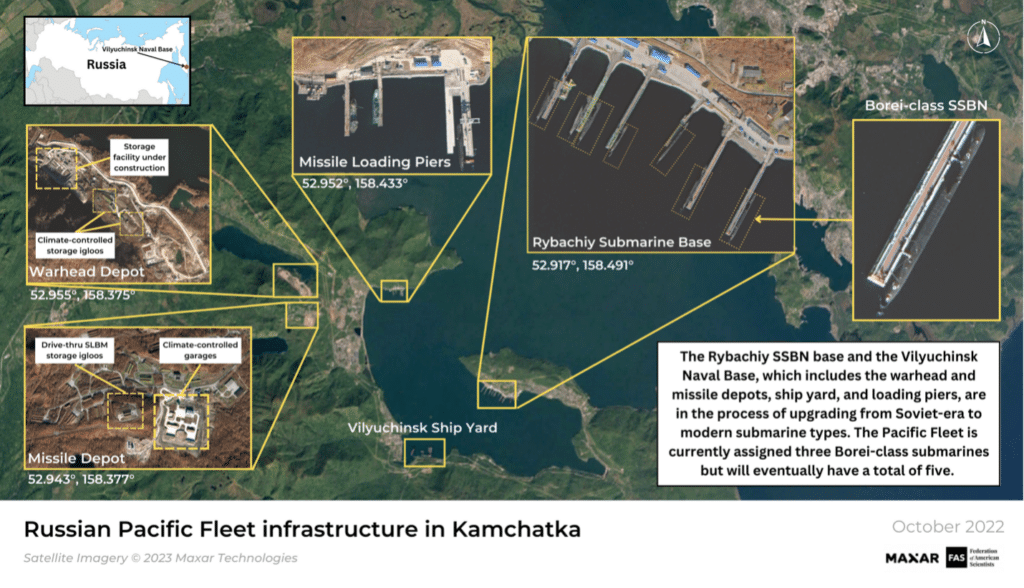
The keel of the sixth boat—Generalissimus Suvorov—was laid down in December 2014 for possible completion in 2018 but also suffered delays. In December 2020, Russian Defense Minister Sergei Shoigu declared that the Navy was expected to receive the Generalissimus Suvorov in 2021 (Russian Federation 2020). The boat was launched in December 2021 and delivered to the Navy in December 2022 from where it was sent to its temporary base with the Northern Fleet (Sevmash 2021a; TASS 2023a).
The keel for the seventh boat—Emperor Alexander III—was laid down in December 2015 for scheduled delivery in 2019 but also experienced delays. It was launched in December 2022, and likely will begin sea trials in June 2023 before being delivered to the Navy’s Pacific Fleet in December 2023 (TASS 2021e, 2022d).
The keel for the eighth Borei SSBN—Knyaz Pozharsky—was laid in December 2016 and scheduled for potential launch between 2021 and 2023, but as of writing this had not yet occurred (Russian Federation Defense Ministry 2016).
The keels for the ninth and 10th Borei SSBNs—Dmitry Donskoy and Knyaz Potemkin—were laid in August 2021 (Sevmash 2021b). The Dmitry Donskoy shared its name with Russia’s last Typhoon-class SSBN, which operated as a weapons testing platform and was decommissioned in early 2023 (TASS 2023b). These two SSBNs are scheduled to be delivered by the completion of the State Armaments Program in 2027, bringing the total fleet up to 10 boats (Russian Federation 2021b). Eventually, five SSBNs will be assigned to the Northern Fleet, and five will be assigned to the Pacific (TASS 2018b).
In February 2022, Russia conducted its annual nuclear force readiness exercise, during which several Kalibr cruise missiles were launched, and a Delfin-class nuclear-powered submarine launched a Sineva SLBM from the Barents Sea (Russian Federation 2022g). A Sineva ballistic missile was also launched from the Barents Sea as a part of Russia’s strategic nuclear forces exercise in October 2022 (TASS 2022e). In 2019, technical malfunctions during the strategic exercises prompted aborted SLBM launches, and required the use of backup launch systems, for the 3M–54 Kalibr cruise missile launches (Sidorkova and Kanaev 2019).
The Russian Navy is also developing the Status-6 Poseidon mentioned above—a nuclear-powered, very long range, nuclear-armed torpedo. Underwater trials began in December 2018. The weapon, scheduled for delivery in 2027, will be carried by specially configured submarines (TASS 2018c). The first of these special submarines—the Project 09852 Belgorod (K-329)—was launched in April 2019 and was originally scheduled for delivery to the Navy by the end of 2020; however, it began sea trials in June 2021 and returned to dry dock in October 2021 (Sutton 2021a, 2021b). Russian defense sources indicated that the “first batch” of Poseidon torpedoes had been produced and would soon be delivered to the Belgorod submarine, despite an apparent aborted test of the torpedo in November 2022 (TASS 2023c; Sciutto 2022). In addition, a throw test of a Poseidon mock-up using the Belgorod was completed in January 2023 (TASS 2023d).
Belgorod will become Russia’s largest submarine and reportedly will be capable of carrying up to six Poseidon torpedoes (TASS 2019b). It was seen operating in the Barents Sea throughout September 2022 (Sutton 2022), although it is unclear if the Poseidon is already operational. The launch of the second Poseidon-capable submarine—Project 09851 Khabarovsk—was expected to take place in the autumn of 2021, but appears to have been delayed until 2023 (TASS 2021f; Starchak 2023a). Khabarovsk will reportedly also be capable of carrying up to six Poseidon torpedoes (TASS 2020d).
Strategic bombers
Russia operates two types of nuclear-capable heavy bombers: the Tu-160 Blackjack and the Tu-95 MS Bear-H. We estimate that there are roughly 68 bombers in the active inventory, of which perhaps only 55 are counted as deployed under New START. Both bomber types can carry the nuclear AS-15 Kent (Kh-55) air-launched cruise missile and upgraded versions are being equipped to carry the new AS-23B (Kh-102) nuclear cruise missile. Two versions of the Tu-95 are thought to exist: Tu-95H6, which can carry up to six missiles internally, and Tu-95H16, which was built to carry missiles both internally and on wing-mounted pylons for a total of 16 missiles. The Tu-95 modernization program is equipping the Tu-95s to carry eight AS-23B missiles externally for a maximum of 14 missiles per aircraft (if it can still carry AS-15s internally). The Tu-160s are also being modernized to carry up to 12 AS-23B internally. The new AS-23B being added during bomber modernization will likely replace the AS-15.
It is unclear how many nuclear weapons are assigned to the heavy bombers. Each Tu-160 can carry up to 40,000 kilograms (about 44 tons) of ordnance, including 12 nuclear AS-15B air-launched cruise missiles, whereas the Tu-95 MS can carry six to 16 cruise missiles, depending on configuration. Combined, the bombers could potentially carry over 800 weapons, but we estimate that weapons only exist for deployed bombers for a total of approximately 580 bomber weapons, as other nuclear-armed states tend not to retain significantly more nuclear weapons than can be carried by their deployed force. Of these, we estimate that given the sizes of the nuclear storage bunkers, roughly 200 are stored at Russia’s two strategic bomber bases—Engels in Saratov oblast and Ukrainka in Amur oblast—and the rest are thought to be in central storage. The Tu-160 may also have a secondary mission with nuclear gravity bombs, but it seems unlikely that the old and slow Tu-95 would stand much of a chance against modern air defense systems.[2] Modernization of the nuclear weapons storage bunker at Engels Air Base continued throughout 2022.[3] Russia has used both Tu-160s and Tu-95 bombers in combat roles throughout the war in Ukraine, which has resulted in some of Russia’s strategic bombers being damaged; at least two Tu-95 bombers were visibly damaged as a result of a likely Ukrainian airstrike on Engels air base in December 2022 (Cenciotti 2022; Röpcke 2022) (see Figure 3).
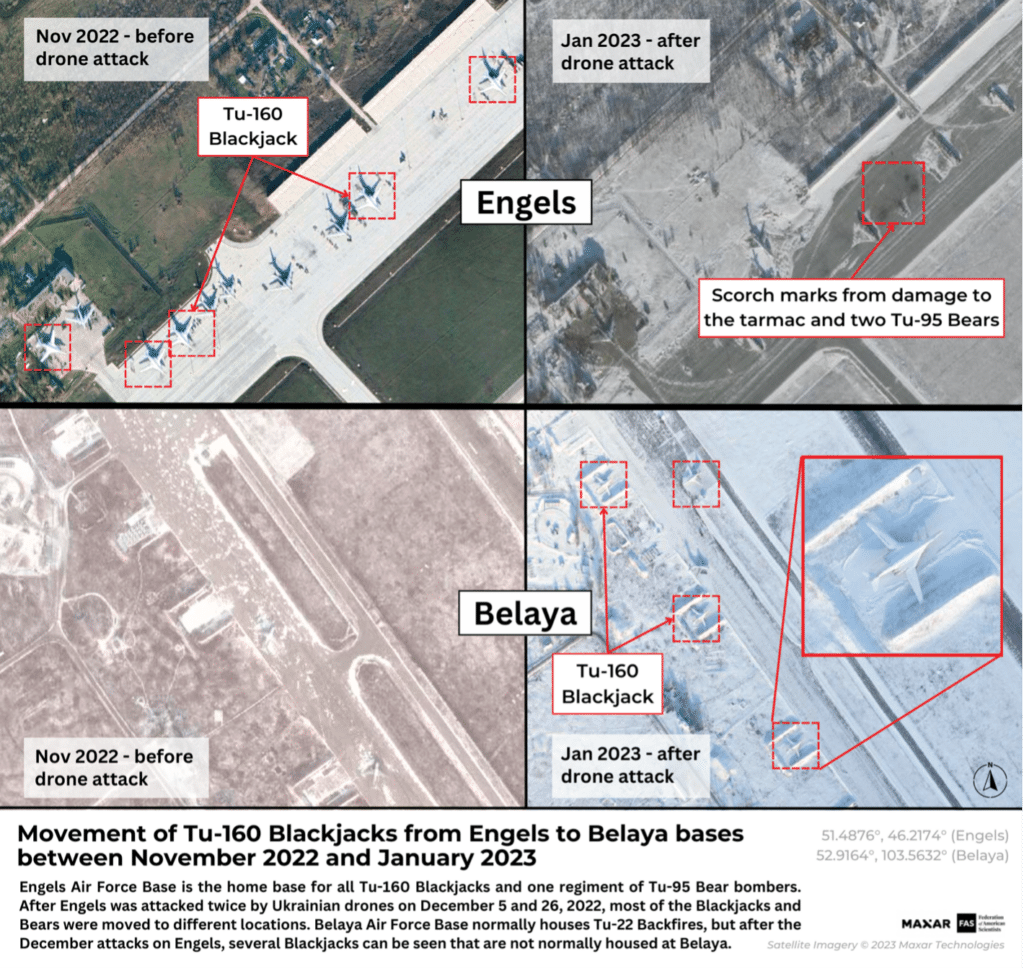
In addition to the armament upgrades to both types of strategic bombers, Russia is conducting a significant modernization campaign for its aging Tu-160 force. However, there is some confusion with regards to the nomenclature of the upgraded planes, with various news outlets using Tu-160, Tu-160 M, Tu-160M1, and Tu-160 M2 designations interchangeably. It appears that all upgraded Tu-160s fall under the Tu-160 M designation, and the M1 and M2 suffixes refer to successive phases of modernization—the first of which reportedly includes a new engine—the NK-32-02—that is said to increase the aircraft’s range by approximately 1,000 kilometers (TASS 2017), as well as a new autopilot system and the removal of obsolete components, and the second of which includes a new radar, cockpit, communications, and avionics equipment (TASS 2020c, 2020e). Some of the Tu-160Ms are being modernized with brand-new airframes, as the Russian Aerospace Forces currently does not have enough existing Tu-160 airframes to accommodate the 50-aircraft order made by the Russian Aerospace Force (Russian Federation 2018b; Krasnaya Zvezda 2020; Butowski 2016; TASS 2018d). During Putin’s 2018 factory visit in Kazan, he described the requirement for the new aircraft: “The older version of this plane was discontinued in 1993. In 2015, we decided to modernize it and resume production. This, in fact, is a completely different aircraft, including avionics and everything else. [. . .] It may look the same, but the engine, the flight range and the capacity are different” (Russian Federation 2018b).
The Tu-160 M’s first flight with its older engine was conducted in February 2020, and the aircraft’s first flight with its next-generation engine took place in November 2020, although the United Aircraft Corporation declined to show pictures of the November test flight due to classification concerns, instead electing to couple its announcement with pictures of an older version of the plane (United Aircraft Corporation 2020). A second Tu-160 M, converted from an older Tu-160 airframe, began ground tests at the Gorbunov factory in December 2020 and flight tests in January 2022 (TASS 2020f; Ignatyeva 2023). The first newly manufactured Tu-160 M bomber conducted its maiden flight in January 2022 (United Aircraft Corporation 2022a). Delivery of the first two Tu-160 Ms to the Russian Aerospace Forces for flight-testing was delayed by several months until January 2023 (Ignatyeva 2023). The third Tu-160 M is reportedly still being assembled (TASS 2023e). Flight tests of the Tu-160 M are expected to last up to three years, indicating a potential entry into combat service around 2025 (Starchak 2023b).
The delays associated with the Tu-160 M program have been so severe that the Russian Ministry of Industry and Trade has filed a lawsuit against the aircraft manufacturer (Interfax 2022f). It is possible that the eventual target of 50 new Tu-160 M bombers might not be reached, but if it does, it would probably result in the retirement of most, if not all, of the remaining Tu-95MSs, which are expected to be retired before 2035.
The Tu-160 modernization program, meanwhile, is only a temporary bridge to the next-generation bomber known as PAK-DA, the development of which has been underway for several years. The Russian government signed a contract with manufacturer Tupolev in 2013 to construct the PAK-DA at the Kazan factory. Research and development work on the PAK-DA has reportedly been completed, and the aircraft is expected to share many systems with the Tu-160 M (TASS 2019c). Construction of the first aircraft’s cockpit reportedly began in the spring of 2020, and final assembly has been postponed from 2021 to 2023 in advance of flight trials (TASS 2020g, 2021h). Preliminary tests of the PAK-DA are scheduled for April 2023 (to be completed by fall 2025), and state tests are scheduled for February 2026. Initial production is expected to begin in 2027, with serial production beginning in 2028 or 2029 (Izvestia 2020; TASS 2019d). However, it is unclear whether the Russian aviation industry has enough capacity to develop and produce two strategic bombers at the same time, and as such this development schedule could face delays.
Nonstrategic nuclear weapons
Russia is updating many of its shorter-range, so-called “nonstrategic” nuclear weapons and introducing new types. This effort is less clear and comprehensive than the strategic forces modernization plan but also involves phasing out Soviet-era weapons and replacing them with newer but fewer weapons. New systems are being added, which prompted the Trump administration’s Nuclear Posture Review to accuse Russia of “increasing the total number of [nonstrategic nuclear] weapons in its arsenal, while significantly improving its delivery capabilities” (US Department of Defense 2018, 9). In the longer term, though, the emergence of more advanced conventional weapons could potentially result in reduction or retirement of some existing nonstrategic nuclear weapons.
Regardless of the number, the Russian military continues to attribute importance to nonstrategic nuclear weapons for use by naval, tactical air, and air and missile-defense forces, as well as on short-range ballistic missiles. Part of the rationale is that nonstrategic nuclear weapons are needed to offset the superior conventional forces of NATO, particularly of the United States. Russia also appears to be motivated by a desire to counter China’s large and increasingly capable conventional forces, and by the fact that having a sizable inventory of nonstrategic nuclear weapons helps Moscow keep overall nuclear parity with the combined nuclear forces of the United States, the United Kingdom, and France.
After the 2018 Nuclear Posture Review was published, defense sources distributed inaccurate and exaggerated information in Washington that attributed nuclear capability to several Russian systems that had either been retired or were not, in fact, nuclear. Moreover, although the Nuclear Posture Review claimed that Russia has increased its nonstrategic nuclear weapons over the past decade, the inventory has in fact declined significantly—by about one-third—during that period (Kristensen 2019). Moreover, although the 2018 Nuclear Posture Review stated that Russia has “up to 2,000” nonstrategic nuclear weapons and defense officials frequently have claimed it has more than 2,000, the US Defense Intelligence Agency’s Worldwide Threat Assessment in 2021 stated that “Russia probably possesses 1,000 to 2,000 nonstrategic nuclear warheads” (US Defense Intelligence Agency 2021, 54). The range reflects difference estimates within the US intelligence community; the military uses the higher number. Rumors emerged in early-2022 that some in the Intelligence Community believe the number of Russian non-strategic nuclear weapons could increase significantly—potentially doubling—by 2030 (Bender 2022; Kristensen 2022).[4]
We estimate that Russia today has approximately 1,816 nonstrategic nuclear warheads, potentially fewer: The US Department of State’s treaty compliance report from 2022 assesses that “Russia currently has an active stockpile of 1,000 to 2,000 [non-strategic nuclear weapons], including warheads awaiting dismantlement” (US Department of State 2022c, 11; emphasis added). These warheads are assigned for delivery by air, naval, ground, and various defensive forces. Although there are many rumors about greater inventories and additional nuclear systems, there is little authoritative public information available. This estimate—and the categories of Russian weapons that we have been describing in the Nuclear Notebook for years—accords with that of the 2022 treaty compliance report (see above) and 2018 Nuclear Posture Review, which stated:
Russia is modernizing an active stockpile of up to 2,000 nonstrategic nuclear weapons, including those employable by ships, planes, and ground forces. These include air-to-surface missiles, short range ballistic missiles, gravity bombs, and depth charges for medium-range bombers, tactical bombers, and naval aviation, as well as anti-ship, anti-submarine, and anti-aircraft missiles and torpedoes for surface ships and submarines, a nuclear ground-launched cruise missile in violation of the 1987 Intermediate-Range Nuclear Forces Treaty, and Moscow’s antiballistic missile system (US Department of Defense 2018, 53).
This assessment constituted the first substantial official US public statement on the status and composition of the Russian nonstrategic nuclear arsenal in over two decades, even though it also raises questions about assumptions and counting rules. Most of the nonstrategic weapon systems are dual-capable, which means not all platforms may be assigned nuclear missions and not all operations are nuclear. Moreover, even though Russia may increase a category of dual-capable launchers, this would not necessarily mean that the number of nuclear warheads assigned to that category is also increasing. Finally, many of the delivery platforms are in various stages of overhaul and would not be able to launch nuclear weapons at this time.
Sea-based nonstrategic nuclear weapons
As far as we can ascertain, the biggest user of nonstrategic nuclear weapons in the Russian military is the navy, which we estimate has roughly 835 warheads—approximately 100 fewer than the previous year due to estimated fluctuations in Russian force structure—for use by land-attack cruise missiles, anti-ship cruise missiles, anti-submarine rockets, anti-aircraft missiles, torpedoes, and depth charges. These weapons may be used by submarines, aircraft carriers, cruisers, destroyers, frigates, corvettes, and naval aircraft. The actual number of sea-based nonstrategic nuclear weapons may be lower than our estimate of 835 because not all vessels with dual-capable weapon systems may be assigned nuclear warheads.
Major naval modernization programs focus on the next class of nuclear attack submarines, known in Russia as Project 885/M or Yasen-M. The program is progressing very slowly. The first of these boats—known as Severodvinsk—finally entered service in 2015 after 16 years of construction and is thought to be equipped with a nuclear version of the 3M—14 Kalibr (SS-N-30A) land-attack sea-launched cruise missile (Gertz 2015). The second boat, and the lead ship of the improved Yasen-M class—known as Kazan—was originally scheduled to join the Northern Fleet in late 2019 (TASS 2018e); however, the boat was delayed due to the poor results of its dockside trials, which indicated that “some of the ship’s auxiliary sub-assemblies and mechanisms do not meet the requirements of the specifications set by the Defense Ministry” (TASS 2019e). The Kazan underwent sea trials in late 2020, successfully hitting a target over 1,000 kilometers away with a Kalibr cruise missile (TASS 2020h). The Kazan was delivered to the Navy in May 2021 and is now operational with the Northern Fleet (TASS 2021g). The next Yasen-M boat— the Novosibirsk—began sea trials in July 2021, was delivered to the Navy’s Pacific Fleet in December 2021, and became operational in 2022 (Manaranche 2021; Sevmash 2021c).
Six additional Yasen-M nuclear-powered nuclear-armed guided missile submarines (SSGNs)—named Krasnoyarsk, Arkhangelsk, Perm, Ulyanovsk, Voronezh, and Vladivostok—are under various stages of construction. The Krasnoyarskwas launched in July 2021 and began conducting its sea trials in late 2022 (TASS 2022f). The five other boats were laid down in 2015, 2016, 2017, 2020, and 2020, respectively (RIA Novosti 2015; TASS 2016, 2020i). Russia is reportedly considering building two additional Yasen-M SSGNs, although this has yet to be officially confirmed (TASS 2022g).
The first Yasen submarine is reportedly 10 to 12 meters longer than the improved Yasen-M submarine and can therefore accommodate 40 Kalibr missiles—eight more than its successors (Gady 2018). The Yasen-M boats reportedly also have improved reactors and sonar systems, which may enhance their ability to evade detection (Kaushal et al. 2021).
In addition to dual-capable Kalibr land-attack cruise missiles, the Yasen-class submarines will also be able to deliver the SS-N-27 Sizzler (3M–54) anti-ship cruise missile, the SS-N-26 Strobile (3M–55) anti-ship cruise missile—which the US Air Force’s National Air and Space Intelligence Center says is “nuclear possible”— the SS-N-16 (Veter) nuclear anti-submarine rockets, as well as nuclear torpedoes (US Air Force 2020, 36). Additionally, in October 2021 and 2022, the Severodvinsk successfully test-launched the 3M–22 Tsirkon (SS-NX-33) hypersonic missile from surface and sub-surface positions—the first tests of the new system from a submarine (TASS 2021h, 2023f). According to Russian military officials, the Yasen-M submarines can salvo-launch several different types of missiles using modernized UKSK-M “universal launchers” that can accommodate multiple systems (Ramm, Surkov, and Dmitriev 2017; Interfax 2021; TASS 2021i).
Other upgrades of naval nonstrategic nuclear-capable platforms include those planned for the Sierra class (Project 945), the Oscar II class (Project 949A), and the Akula class (Project 971). While the conventional version of the Kalibr is being fielded on a wide range of submarines and ships, the nuclear version will likely replace the current SS-N-21 (Sampson) nuclear land-attack cruise missile on select attack submarines. There is also speculation that Russia might consider building a new type of cruise missile submarine based on the Borei SSBN design, which would be called Borei-K. The Borei-Ks could potentially carry nuclear-armed cruise missiles instead of ballistic missiles, and if they were approved then they would be scheduled for delivery after 2027 (TASS 2019f). However, given that the incoming Yasen-M submarines are also capable of delivering nuclear-armed cruise missiles, there may be no need for a new type of SSGN.
Air-based nonstrategic nuclear weapon
The Russian Air Force is the military’s second-largest user of nonstrategic nuclear weapons, with roughly 500 such weapons assigned for delivery by Tu-22M3 (Backfire) intermediate-range bombers, Su-24M (Fencer-D) fighter-bombers, the new Su-34 (Fullback) fighter-bomber, and the MiG-31K. All types can deliver nuclear weapons.
A total of four regiments are now equipped with the new Su-34, which is replacing the Su-24, with more than 145 aircraft delivered so far (Scramble 2023). Russia is also purchasing an additional 76 upgraded units of the Su-34M with improved avionics, of which 14 had reportedly been delivered as of March 2023 (Lavrov and Krezul 2020; Scramble 2023).
The Tu-22M3 can also deliver Kh-22 (AS-4 Kitchen) air-launched cruise missiles, which is being replaced by an upgraded version known as Kh-32. The Tu-22M3 and Su-24M are also being upgraded, and the new Tu-22M3M—which reportedly contains 80 percent entirely new avionics and shares a communications suite with the new Su-57 fighter—conducted its maiden flight in December 2018 (United Aircraft Corporation 2018; TASS 2020j). The second prototype of the upgraded Tu-22M3M conducted its first flight in March 2020, and has since conducted four additional flight tests—one of which tested the plane’s resilience at supersonic speeds (TASS 2020k). The Tu-22M3M—in addition to the Tu-160M and future PAK-DA strategic bombers—will eventually be equipped with a new Kh-95 hypersonic missile, a prototype of which has reportedly already been tested (RIA Novosti 2021b).
It is possible that the Russian Air Force also has various types of other guided bombs, air-to-surface missiles, and air-to-air missiles with nuclear capability. If they exist, however, these systems would probably already be included in the Defense Intelligence Agency’s estimate of 1,000 to 2,000 nonstrategic warheads (US Defense Intelligence Agency 2021, 54).
Russia has also developed a new long-range, dual-capable, air-launched ballistic missile system known as the 9-A-7760 Kinzhal. The missile, which appears similar to the ground-launched SS-26 short-range ballistic missile used on the Iskander system, allegedly has a range of up to 2,000 kilometers if launched from a specially modified MiG-31K (Foxhound) designated as MiG-31IK, and up to 3,000 kilometers if launched from the Tu-22M3 bomber (the range is the combined combat range of the aircraft plus the missile). The MiG-31IK cannot carry both the Kinzhal and its regular air-to-air missiles and must therefore be deployed alongside a protective air detail (TASS 2018f). In December 2021, Defence Minister Shoigu announced that in 2021 “a separate aviation regiment was formed, armed with MiG-31IK aircraft with the Dagger hypersonic missile” (Russian Federation 2021a), apparently in the North Fleet area on the Kola Peninsula. Plans reportedly are underway to equip the Western and Central Military Districts with Kinzhal missiles by 2024 (Izvestia 2021; TASS 2021j). The Kinzhal was used in combat for the first time in March 2022 during the war in Ukraine, and Russian Defense Ministry Sergei Shoigu noted in August 2022 that the missile had been used on three separate occasions during the conflict (TASS 2022h). In February 2023, President Putin announced that Russia would speed up mass production of Kinzhal (TASS 2023g).
Additionally, the Russian Aerospace Force reportedly received its first batch of Su-57 (PAK-FA) fighter jets in late 2020 and deliveries continued through 2022 (TASS 2020l; United Aircraft Corporation 2022b). The delivery of 22 aircraft is scheduled by the end of 2024, and the full contract is expected to comprise 76 planes for delivery by the end of 2028 (Suciu 2021; TASS 2020m). The US Department of Defense says that the Su-57s are nuclear-capable (US Department of Defense 2018). They will reportedly also be equipped with hypersonic “missiles with characteristics similar to that of the Kinzhal” (TASS 2018g).
Nonstrategic nuclear weapons in missile defense
Russian officials said over a decade ago that about 40 percent of the country’s 1991 stockpile of air defense nuclear warheads remained in Russia’s nuclear stockpile. Alexei Arbatov, then a member of the Russian Federation State Duma defense committee, wrote in 1999 that the 1991 inventory included 3,000 air defense warheads (Arbatov 1999). Many of those were probably from systems that had been retired, and US intelligence officials estimated that the number had declined to around 2,500 by the late 1980s (Cochran et al. 1989), in which case the 1991 inventory might have been closer to 2,000 air defense warheads. In 1992, Russia promised to destroy half of its nuclear air defense warheads, but Russian officials said in 2007 that 60 percent had been destroyed (Pravda 2007). If those officials were correct, the number of nuclear warheads for Russian air defense forces in 2007 might have been 800 to 1,000.
The 2018 Nuclear Posture Review claimed that Russia continues to use nuclear warheads in its air and missile defense forces; however, the document did not identify which systems have dual-capability or how many are assigned nuclear warheads. The US Defense Intelligence Agency said in its March 2018 Worldwide Threat Assessment that: “Russia may also have warheads for surface-to-air and other aerospace defense missile systems” (Ashley 2018).
Russia currently operates several different kinds of missile defense complexes for use against different tiers of threats. The A-135 antiballistic missile defense system around Moscow is equipped with 68 nuclear-tipped 53T6 Gazelle interceptors. In addition, the mobile S-300 and S-400 systems are designed for theater air and missile defense, and US government sources privately indicate that both the S-300 (SA-20) and S-400 (SA-21) are dual-capable.
Russia is developing several next-generation air and missile defense systems to supplement—and in some cases replace—its older systems. An upgrade of the A-135 to the A-235 Nudol is expected to be complete by the end of 2023; however, it is possible that the A-235 system will not be equipped with nuclear warheads and will instead rely on conventional warheads or kinetic hit-to-kill technology (Krasnaya Zvezda 2017; Starchak 2023c). Other incoming Russian missile defense systems—including the S-550 and Aerostat, as well as the S-350 replacing the S-300—are expected to utilize conventional warheads rather than nuclear ones; however, their improved ranges and speeds will also likely offer them the capabilities to target satellites in orbit (Hendrickx 2021; TASS 2021k).
Assuming that the inventory of nuclear weapons assigned to Russian air and missile defenses has shrunk further since 2007 (due to the improving capabilities of conventional air-defense interceptors and continued retirement of excess warheads), we estimate that nearly 290 nuclear warheads are available for air defense forces today, plus an estimated 90 additional warheads for the Moscow A-135 missile defense system and coastal defense units, making a total inventory of about 380 warheads. However, it must be emphasized that this estimate, because of limited transparency and authoritative sources, comes with considerable uncertainty and low confidence about its accuracy.
Ground-based nonstrategic nuclear weapons
Russian Defense Minister Sergei Shoigu announced in December 2019 that the upgrade of all army missile brigades to the 350-kilometer range SS-26 (Iskander) short-range ballistic missile had been completed (Russian Federation 2019), but construction continues at several bases four years later and not all have missile depots (see Figure 4). This includes at least 12 brigades: four in the Western Military District; two in the Southern Military District; two in the Central Military District, and at least four in the Eastern Military District. Each brigade has 12 launchers, each with two missiles for a total of 24 missiles (at least one reload is in storage). In 2019, Izvestia quoted unnamed defense ministry sources saying that each brigade would receive an additional battalion so that each brigade in the future would have 16 launchers with 32 missiles (Izvestia 2019). We estimate that there are roughly 70 warheads for short-range ballistic missiles. Unconfirmed rumors suggest that the SSC-7 (9M728 or R-500) ground-launched cruise missile may also have nuclear capability.
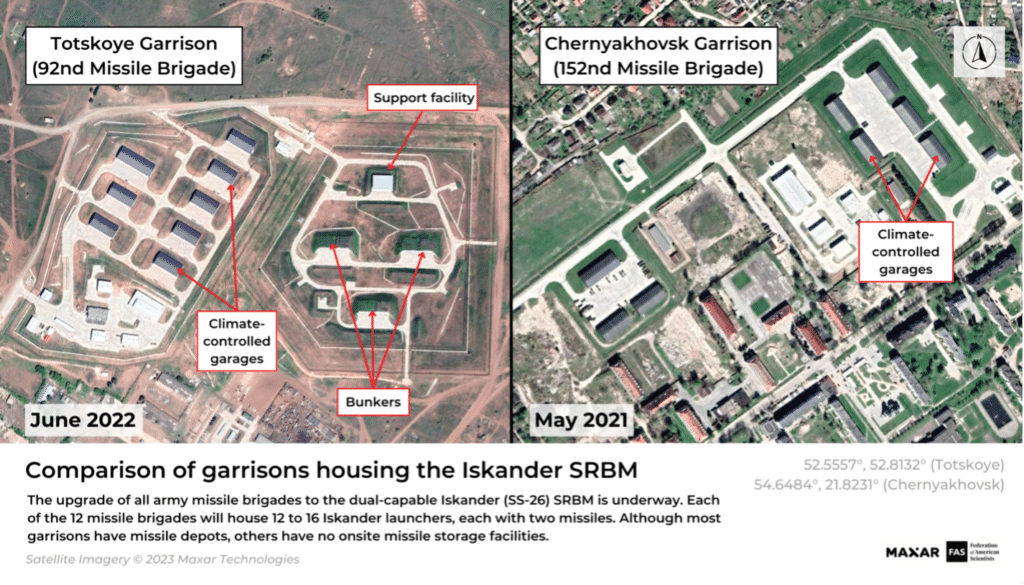
In February 2023, Belarussian military officials claimed that they were autonomously operating Russian-supplied nuclear-capable SS-26 Iskander missile systems in the context of the war in Ukraine, and they were spotted training at a base near Osipovichi later that month (Reuters 2023b; Kristensen 2023). Russia also claims to be constructing a nuclear storage site for tactical nuclear weapons in Belarus, for which the Russian-supplied Iskanders could be a potential carrier (Smotrim 2023). However, at this stage it remains highly unclear whether Russia actually intends to deploy nuclear weapons to Belarus, or if it is instead building the infrastructure to do so in the future.
Russia has also developed and deployed a dual-capable ground-launched cruise missile—identified as the 9M729 (SSC-8)—in violation of the now-defunct Intermediate-Range Nuclear Forces Treaty (US Department of State 2019). The first two 9M729 battalions were deployed in late 2017 (Gordon 2017), and US intelligence sources indicated in December 2018 that Russia had deployed four battalions in the Western, Southern, Central, and Eastern Military Districts with nearly 100 missiles (including spares) (Gordon 2019). We estimate that these four battalions are co-located with the Iskander sites at Elanskiy, Kapustin Yar (possibly moved to a permanent base by now, possibly in the Far East), Mozdok, and Shuya.
It is unknown if Russia has added 9M729 battalions beyond the four reported in December 2018. There is no public confirmation that it has, but in February 2019, only a few weeks after Russia acknowledged the existence of the 9M729 but claimed its range was legal, the press service of Russia’s Western Military District reported it had carried out “electronic launches” of the 9M279 in the Leningrad region (RIA Novosti 2019). This could potentially indicate the 9M729 has been added to a fifth brigade (the 26th Missile Brigade outside Luga about 125 kilometers south of St. Petersburg) or that launchers were sent there for training. And in December 2019, Izvestia reported that the Russian military planned to add a fourth battalion to each existing Iskander brigade, each of which previously comprised three battalions of four launchers each (each launcher carries two missiles and probably two reloads) (Izvestia 2019). It remains to be seen if this means that 9M729 launchers will be added to all of Russia’s 12 Iskander brigades.
Endnotes
[1] We estimate that Russia stores its nuclear weapons at approximately 40 permanent storage sites across the country, including about 10 national-level central storage sites (Kristensen and Norris 2014, 2–9; US Department of State 2022d, 10). Essential references for following Russian strategic nuclear forces include the general New START aggregate data that the US and Russian governments release biannually; BBC Monitoring; Pavel Podvig’s website on Russian strategic nuclear forces (Podvig n.d.); and the Russia profile maintained by the James Martin Center for Nonproliferation Studies (2018) on the Nuclear Threat Initiative website.
[2] One normally well-informed source said there are no nuclear gravity bombs for the Tu-95 MS and Tu-160 aircraft (Podvig 2005).
[3] Russia is also adding conventional cruise missiles to its bomber fleet, a capability that was showcased in September 2015 when Tu-160 and Tu-95 MS bombers launched several long-range conventional Kh-555 and Kh-101 cruise missiles against targets in Syria, and throughout 2022 and 2023 during the war in Ukraine. New storage facilities have been added to Russia’s bomber bases over the past few years that might be related to the introduction of conventional cruise missiles.
[4] A US government telegram stated in September 2009 that Russia had “3,000–5,000 plus” nonstrategic nuclear weapons (Hedgehogs.net 2010), a number that comes close to our estimate at the time (Kristensen 2009). The US deputy undersecretary of defense for policy, James Miller, stated in 2011 that nongovernmental sources estimated Russia might have 2,000 to 4,000 nonstrategic nuclear weapons (Miller 2011). The US Department of State assessed in 2022 that Russia had an active stockpile of 1,000 – 2,000 nonstrategic nuclear warheads, including warheads awaiting dismantlement (US Department of State 2022d, 11). For a more in-depth overview of Russian and US nonstrategic nuclear weapons, see Kristensen (2012). Some analysts estimated that Russia has significantly fewer warheads assigned to nonstrategic forces (Sutyagin et al. 2012).
Disclosure statement
No potential conflict of interest was reported by the authors.
Funding
This research was carried out with generous contributions from the John D. and Catherine T. MacArthur Foundation, the New-Land Foundation, the Ploughshares Fund, the Prospect Hill Foundation, Longview Philanthropy, the Stewart R. Mott Foundation, the Future of Life Institute, Open Philanthropy, and individual donors.
Together, we make the world safer.
The Bulletin elevates expert voices above the noise. But as an independent nonprofit organization, our operations depend on the support of readers like you. Help us continue to deliver quality journalism that holds leaders accountable. Your support of our work at any level is important. In return, we promise our coverage will be understandable, influential, vigilant, solution-oriented, and fair-minded. Together we can make a difference.
Keywords: Nuclear Notebook, Russia, ballistic missiles, bombers, delivery systems, nuclear arsenal, nuclear risk, nuclear weapons
Topics: Nuclear Notebook, Nuclear Risk, Nuclear Weapons
